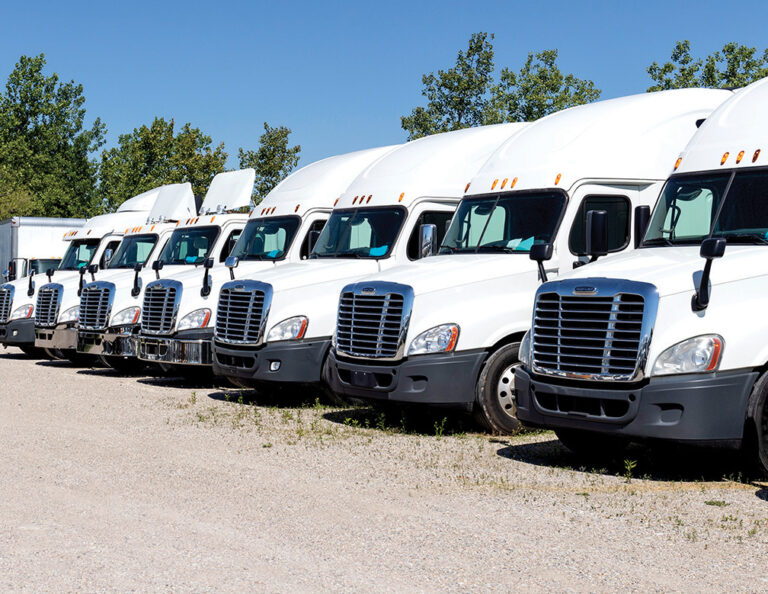In June, U.S. sales of new Class 8 trucks experienced the best month of the year to date, according to data received from ACT Research. Only one month — December 2021 — has seen higher sales numbers since the pre-pandemic month of December 2019.
Manufacturers reported sales of 22,850 in the month, an increase of 1,578 trucks (7.4%) over May sales, which were the previous high for this year. Compared with last year’s June sales of 20,369, the increase was 12.2%.
June was the second-best month since 2019. Only sales in December 2021 exceeded June 2022.
“We had the best production month in the entire cycle in June,” said Kenny Vieth, president and senior analyst for industry forecaster ACT Research. “June was materially above the build rate trends.”
The increased sales may be an indication that supply chain issues, such as the difficulty in obtaining semiconductors and parts that contain them, may be easing up.
That doesn’t mean supply-chain issues are over, however.
“We don’t know if whether this is an upside breakout due to parts becoming available on a steady basis or it is as simple as a couple of shipments came in, allowing the OEMs to catch up, temporarily,” Vieth said.
Inflationary pressures could also be partly responsible. As consumers spend a greater portion of their income on food and fuel, it leaves less money available for purchase of products that contain semiconductors — which then become available for use in vehicle manufacturing.
Of the Class 8 trucks sold in June on the U.S. market, 5,250 (22.5%) of the total sold were vocational trucks equipped with dump, trash, concrete or other bodies. That’s only a 2.8% increase over sales a year ago in June 2021, while sales of over-the-road, fifth-wheel-equipped tractors rose by 16%.
According to Vieth, “If Daimler is having trouble getting parts and materials, Joe’s body shop is, too.”
Another reason is the price of steel, including tariffs imposed by former president Donald Trump and left in place by Joe Biden. It takes a lot of steel to manufacture some types of truck bodies. The economy plays a part, too, according to Vieth.
“Certainly what’s going on in the economy right now is more likely to impact vocational markets sooner than the over the road market,” he said.
Vieth thinks the truck market will remain strong, at least for a while.
“Vehicle demand remains healthy, if moderating from here, with pent-up demand expected to push into 2023,” he explained in a recent ACT press release. “Finally, some prebuy activity is anticipated prior to the implementation of CARB’s Clean Truck mandate, helping to support activity next year.”
In the meantime, the number of orders placed for 2022 model equipment exceeds the industry’s ability to build them before switching over to 2023 models.
“The North American Class 8 market ended June with a backlog of roughly 223,000 units,” Vieth said. “200,000 units are scheduled for build by the end of this year.”
Since OEMs generally begin building new model year trucks on Jan. 1, many of the current orders for 2022 models will need to be canceled and reordered as 2023 models.
Buyers can also expect increasing prices resulting from rising costs of parts and components. Those who finance new equipment will see an increase in the cost of borrowing as interest rates continue climbing. On June 15 the Federal Reserve raised its benchmark interest rate by three-quarters of a percentage point, the largest such hike since 1994.
Economists expect further hikes by the end of the year, with some predicting another one-half to three-quarter percent rise at the FED’s July meeting.
“That’s certainly one of the big headwinds we see in 2024 and then to 2024,” Vieth said. “Most of the big fleets tend to be cash buyers, so the smaller guys will be impacted most.”
According to data from Wards Intelligence, of the individual truck manufacturers reporting, Freightliner led the way with U.S. sales of 8,129 trucks, good for 36.4% of new Class 8 sales during June. Sales increased 11.2% over May’s 7,309 and 9.5% over sales of 7,426 in June 2021.
Kenworth and Peterbilt sales combined gave PACCAR 29.6% of the U.S. market in June. Kenworth’s 3,194 sold was an increase of 13.9% over May sales of 2,803 and 16.4% higher than sales of 2,743 in June 2021. Peterbilt sales of 3,418 were up 1.3% from May’s 3,375 and 19.9% higher than June 2021 sales of 2,851.
Volvo and Mack combined for 19% of U.S. truck sales in June. Sales of 2,679 Volvo trucks were 5.2% higher than the 2,546 sold in May, while they were a whopping 82% higher than the 1,472 sold in June a year ago. Mack sold 1,560 trucks in June, an increase of 13.7% over May’s 1,372 but a decline of 3.8% from June 2021 sales of 1,704.
International reported sales of 2,927 in June, up 4.6% over May sales numbers but down 3.8% from the 3,043 sold in June 2021. The company sold 13.1% of the new Class 8 trucks sold on the U.S. market in June.
Western Star’s 451 trucks sold in June represent just 2% of the U.S. market — and a decline of 60 trucks or 11.7% from May sales of 511 trucks. Compared to June 2021 when 601 trucks were sold, sales declined by 25.0%
Truck sales are typically stronger in the last month of each quarter, a fact that very likely contributed to the higher June numbers. July, being the first month of the new quarter, usually sees sales numbers that are somewhat lower. With the number of variables presented so far this year, however, no sales prediction is foolproof.
The availability of more parts and components could push production closer to capacity. Another variable are trucks already built, waiting on the lot for one or two final parts to be installed before being sold. If the parts come in, those trucks could be sold without a production increase on the assembly line.
Finally, it’s nearly time for manufacturers to begin producing 2023 model trucks. Buyers could choose to wait for the new models to come out, or could rush to buy 2022 models before prices go up.
Cliff Abbott is an experienced commercial vehicle driver and owner-operator who still holds a CDL in his home state of Alabama. In nearly 40 years in trucking, he’s been an instructor and trainer and has managed safety and recruiting operations for several carriers. Having never lost his love of the road, Cliff has written a book and hundreds of songs and has been writing for The Trucker for more than a decade.















